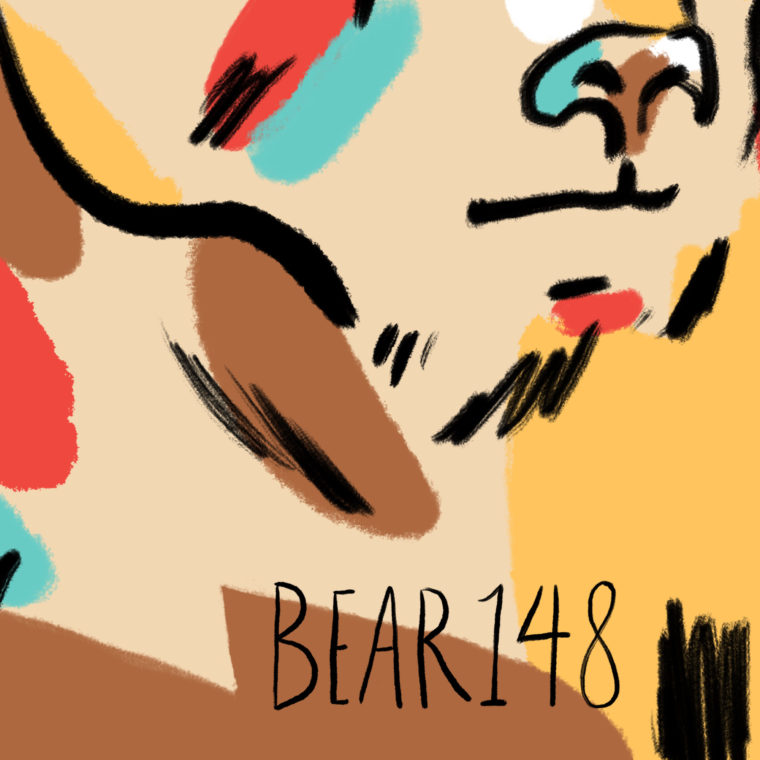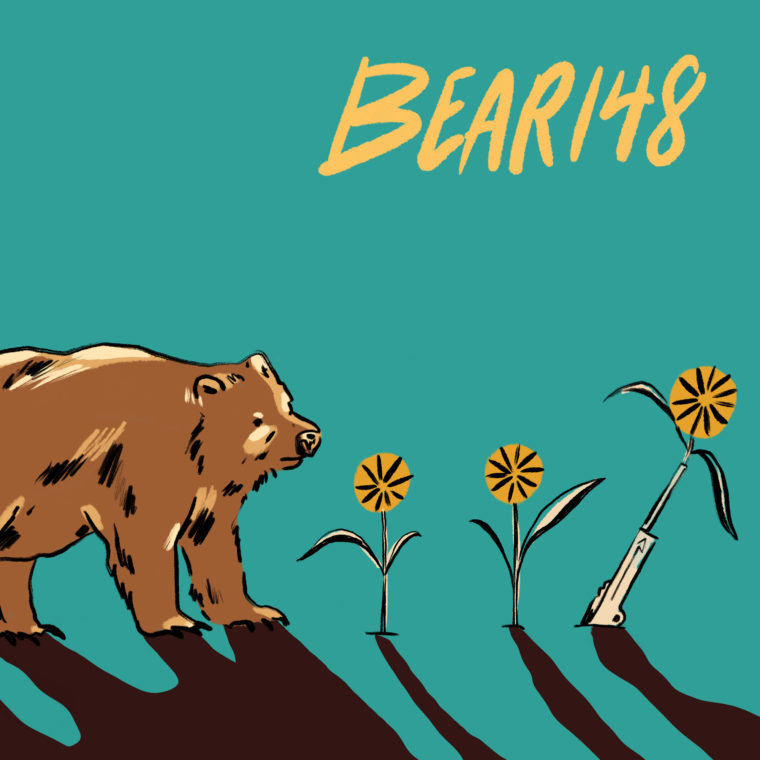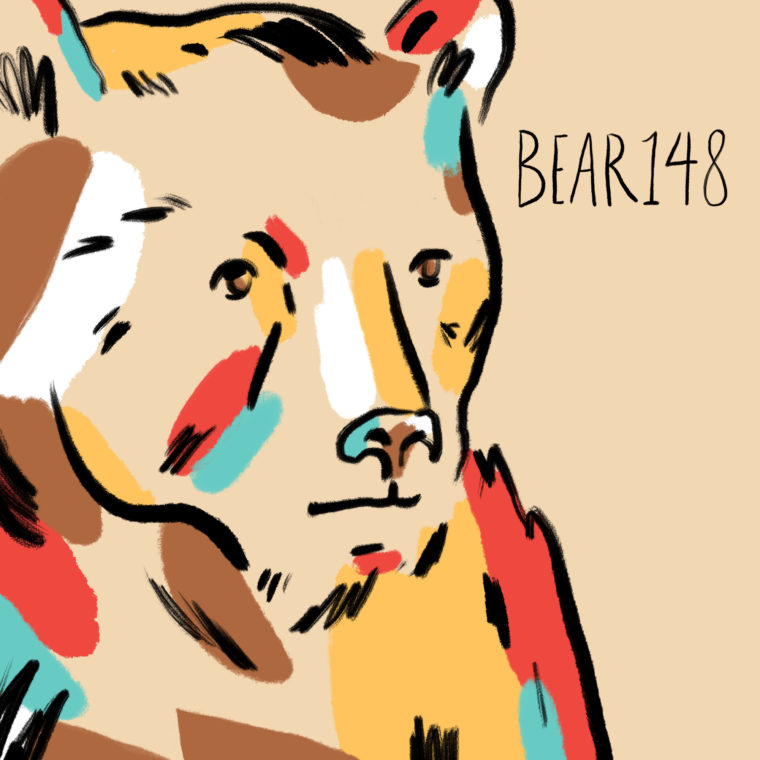People have been mauled and killed by grizzly bears in the Bow Valley.
It’s something most of us don’t have to think about. But for wildlife managers in parks with bears, the worst-case-scenario is never far from mind.
Balancing the potential of that horror happening again with the behaviour of a habituated bear like 148 can feel like “playing Russian roulette,” Jay Honeyman, human-wildlife conflict biologist with Alberta Environment and Parks, says.
Do we wait until human-wildlife interactions become deadly before we intervene? Or is it reasonable to remove a peaceful bear from their habitat when the faintest warning bells begin to sound?
Honeyman said the riddle of what to do about Bear 148 wasn’t a simple one to solve.
“We haven’t found the silver bullet to figure out how to make it work with that level of habituated bear because inevitably our, our public safety radar goes off at some point and … we can’t continue to play this game.”
But in places like Banff National Park it can be difficult for a bear to avoid habituation.
Take the example of Banff’s notorious “bear jams.”
The Bow Valley Parkway is a small, scenic road that runs parallel to the main highway between Banff and Lake Louise. Forested on both sides, the heavily trafficked parkway brings you past campgrounds and trailheads.
The beautiful drive is popular in the spring and summer — especially for tourists hoping to catch a glimpse of a wild animal.
Clearings beside the road make for popular bear grazing spots. But not all road-side stops are the same for bears.
In Banff, bears are welcome to their roadside grazing, whereas outside the park’s boundaries, bears are actively discouraged from grazing by the road with the help of rubber bullets, paintballs, beanbags and noisemakers.
Wildlife biologist Sarah Elmeligi says it’s a challenge for bears when we send them such mixed messages.
“It presents this very complex challenge to managers because on the one hand facilitating roadside bear viewing in Banff National Park is great,” she says. “It really shows people that bears are not inherently violent. It allows the bear to access really important roadside habitat, especially in the spring.”
“But on the flip side … when they leave the national parks and they engage in that same behaviour [it] can get them into pretty significant trouble.”
————
Featured in this episode:
Cameron Westhead, former MLA for Banff-Cochrane
Brett Boukall, Alberta senior wildlife biologist
Bill Hunt, Banff National Park resource conservation manager
Sarah Elmeligi PhD, biologist and author of the forthcoming book “What Bears Teach Us”
Jay Honeyman, human-wildlife conflict biologist with Alberta Environment and Parks
John Borrowman, mayor of Canmore
Undercurrent soundtrack sponsored in part by Approach Media.
Podcast (episodes): Download
Episode Transcript
MOLLY SEGAL: It’s a June evening. It’s one of those days where it seems like the sun will just stay out all night. But I’m inside at a public meeting in downtown Canmore, in the Miners’ Union Hall, to be specific.
Just a quick side note — before Canmore was known as a tourism getaway, it was a mining town. Its population has boomed in the past few decades. That means more buildings and roads and, of course, more people doing stuff like exploring hiking trails. People are gathered this evening largely because of Bear 148.
CAMERON WESTHEAD: Bear 148 wasn’t just a number, she was part of our community.
MOLLY SEGAL: For The Narwhal, this is Bear 148. I’m Molly Segal.
After Bear 148 was killed in British Columbia, many people spoke out. On social media. Writing letters to the editor of the town newspapers. Calling their local and provincial politicians. This one bear’s death shook the community.
Her death was legal — it happened just a couple of months before British Columbia would ban the hunt on grizzly bears. Still, it all highlighted the issues that borders pose to wildlife: what they can and cannot do depending on what land they’ve walked onto. And that’s what we’re going to look at on this episode of Bear 148.
CAMERON WESTHEAD: We’re going to be improving trail signage in the Bow Valley.
MOLLY SEGAL: Right now, you’re hearing Cameron Westhead. At the time, he was the province’s MLA for Banff-Cochrane.
CAMERON WESTHEAD: In the Bow Valley here, it’s a really busy, dense corridor with multiple jurisdictions that share boundaries. So it’s really complicated. There’s lots of people, there’s lots of wildlife.
MOLLY SEGAL: There’s a lot of technical language for what’s going on: Human-Wildlife Coexistence Technical Working Group and Roundtable. What that really means, though, is that politicians, scientists, managers, officials all got together to talk about how people and wildlife interact in the Bow Valley. They came up with an 80-page report that reveals some of the problems wild animals run into when crossing the borders that we’ve created.
BRETT BOUKALL: One of the impetus for us getting together was the management and the fate of Bear 148 last summer.
MOLLY SEGAL: There are many people from the community here, as well as the “working group.” Part of the room is set up like a science fair, with poster boards, maps and photos. All of this to give people a behind-the-scenes look at how the province, towns and national parks manage wildlife and people.
Banff abuts directly on three other national parks: Kootenay, Yoho and Jasper. This is generally where wild animals are safest because they have the most protection. Outside of the national parks things start to change. Let’s begin inside Banff National Park.
I drive to the Banff Warden Office. It’s in the industrial part of town, hidden away from the bustle of tourists.
BILL HUNT: There’s always going to be differences between inside a protected area and outside a protected area. I don’t know if there’s any any easy solutions.
MOLLY SEGAL: This is Bill Hunt. He’s Banff National Park’s Resource Conservation Manager. So he’s often the guy who speaks to all things Banff-related. He’s also the guy who hears about all of the run-ins people have with wild animals in the national park. Like so many other people, Bill has had his own encounter with Bear 148.
BILL HUNT: A very exciting encounter for me.
MOLLY SEGAL: He was cycling a trail that connects Canmore and Banff. He was going pretty fast.
BILL HUNT: I was hollering, making some noise as I went through a windy section of trail, and I ran right into 148 who was in there trying to get some grass and dandelions. She gave me a huff and a swat, swung her paw in the air let me know that I was in her space. I backed away, grabbed my bear spray. Another cyclist who was a friend of mine ran into the back of me and the two of us backed our bikes out of there quite scared and she just went back to feeding. If that had been a wary grizzly bear it could have been a much, much worse outcome for me and the bear.
MOLLY SEGAL: There are some words that come up a lot when talking about grizzly bears in the Bow Valley. Wary and habituated are two of those words. Bill Hunt says habituated means that Bear 148 wasn’t afraid of people. A wary bear is one that tries to avoid people. In Banff, where bears and people both spend time in the same valley, Bill says some degree of habituation is helpful.
BILL HUNT: And so if a bear wasn’t habituated to some degree it simply could survive here, it couldn’t find its way through our narrow wildlife corridors and using underpasses and overpasses to get safely across the highway.
MOLLY SEGAL: But where do they draw the line? Parks Canada doesn’t want bears to become what biologists call “food conditioned.”
MOLLY SEGAL: At what point does that behaviour become problematic? Is it only once they associate humans with food or is there somewhere in between where they start becoming worrisome?
BILL HUNT: When we have bears that are coming into built-up areas. Bears that are trying to use urban or developed areas as a refuge from our larger bears.
MOLLY SEGAL: Like female bears with cubs or what Bill calls teenage bears — both of them trying to avoid large males.
BILL HUNT: That’s when it becomes problematic. And so this is one of the areas where we do have a fairly strong reactionary program. Anytime a carnivore or even elk are seen in those areas, staff work to haze that animal out of there. And our goal there is to teach them that there is a there is a line that they’re not to cross.
These are wildlife and when they are in Banff they’re protected under the National Parks Act.
MOLLY SEGAL: As soon as a bear steps outside of the National Park those rules change. But, how could a bear know when it’s crossing a border?
SARAH ELMELIGI: There’s a philosophical difference about how we should allow bears to use the landscape.
MOLLY SEGAL: I meet Sarah Elmeligi by the Bow River in downtown Canmore. Here, people are out walking and jogging. It’s the middle of the week but it’s busy. Sarah is a biologist and did her PhD work here in the Bow Valley. Her research dove into a lot of the issues that Bear 148 brought into focus.
SARAH ELMELIGI: So we’ve written this very complex rulebook for how a grizzly bear needs to be a good grizzly bear, and we’ve drawn all of these lines on a map and we’ve said okay over here do this and this will happen and do that and this will happen over there. It’s a very complex rulebook and bears can’t read.
MOLLY SEGAL: Bears can’t read. This makes me stop to think about, what is it actually like for bears? Maybe a bear kind of knows the rules in one place. Not in the way we understand those rules, but maybe something more like, ‘hey, turns out those cars by the road are okay! I can still eat dandelions here.’
But then, that same bear goes looking for food in an area that looks similar to the bear, and it gets chased out. I see why that could be confusing.
SARAH ELMELIGI: We’re not really setting them up for success by having so much contradictory responses.
JAY HONEYMAN: Well, our philosophy is to discourage habituation and we want to be encouraging wary bears.
MOLLY SEGAL: This is Jay Honeyman, a human-wildlife conflict biologist with Alberta Environment and Parks. When bears leave the national parks and wander into Kananaskis, Jay’s one of the people deciding what behaviour is okay and what’s a threat to the public.
JAY HONEYMAN: Habituated bears just don’t do well. Generally wildlife that hangs around people, in general, doesn’t do well. The best thing that wildlife could do would be to stay away from us and they’re probably going to do well, they’re going to live a long happy life. And, you know, the more time they come and hang out with people and hang out in urban areas, it’s not going to bode well for them in the long run.
MOLLY SEGAL: One example of how these different rules play out is bears foraging for food near the side of the road — so, eating things like dandelions.
BILL HUNT: We work very hard to make sure that when people stop and do see a habituated bear foraging roadside that they’re staying in their vehicles, they’re keeping the distance, making sure of course that nobody’s feeding wildlife and that those activities are safe.
MOLLY SEGAL: But it doesn’t always happen like that. The Bow Valley Parkway is a small, scenic road that runs parallel to the main highway between Banff and Lake Louise. What’s important to know about this road is just how close to wildlife you are here. There’s forest on both sides of the road. You drive past campgrounds and trails that take you up the rocky peaks that soar above the tree line. It’s a really beautiful drive — and it’s a popular one in spring and summer — especially for people hoping to catch a glimpse of a wild animal. Right beside the road are clearings that in June often have things bears like to eat.
MOLLY SEGAL: It’s quite close to the side of the road really. It’s maybe like, I don’t know, a few metres from the cars. It doesn’t really seem bothered.
MOLLY SEGAL: I made this recording at a bear jam one June. A bear jam happens when people stop their cars to look at a bear and it causes a traffic jam. Anyway, I was out on a drive with a friend.
MOLLY SEGAL: Eight cars. It’s pretty chaotic actually.
MOLLY SEGAL: A lot of the bears in Banff National Park eat things like dandelions along the side of the road. They’re usually used to the cars driving past or stopping. And Parks Canada allows this as long as people are safe, and like Bill says, that means keeping your distance from the bear.
“Hey you got to stay in your car!”
“Well we’re trying to get up there to get a picture.”
MOLLY SEGAL: He says “We’re trying to get a picture.” And to be clear, in this instance, the bear is right next to the road. Parks Canada recommends staying 100 metres away from bears, unless you stay inside your car. But the province has a different approach altogether: discouraging bears from eating near the side of the road. Sarah Elmeligi.
SARAH ELMELIGI: So that is a pretty big difference.
MOLLY SEGAL: In Alberta’s provincial parks.
SARAH ELMELIGI: That’s like bears feeding on dandelions in the ditch will be aversively conditioned away from that behaviour. The challenge with that is that now you have this bear eating dandelions in the ditch in Banff and everything’s good and it’s all happy and there are people there and it’s all fun and then that bear goes to graze dandelions in the ditch in Kananaskis, and it’s used to being around people now. It’s tolerant of people, it doesn’t see people as a threat. But now suddenly it’s being aversively conditioned away from dandelions.
MOLLY SEGAL: “Aversively conditioned away from dandelions.”
Here, Sarah is talking about when Alberta Parks uses things like rubber bullets, bean bags, paintballs and noisemakers — stuff that bears don’t like or that’s unpleasant but that’s not going to hurt the bear — to try and teach the bear not to do something. In this case, not to eat dandelions at the side of the road. It is worth mentioning that there’s some debate among biologists about how and when this method is most effective.
SARAH ELMELIGI: It presents this very complex challenge to managers because on the one hand facilitating roadside bear viewing in Banff National Park is great. It really shows people that bears are not inherently violent. It allows the bear to access really important roadside habitat, especially in the spring. But on the flip side, you’re also teaching these bears bad behaviour that when they leave the national parks and they engage in that same behaviour can get them into pretty significant trouble.
MOLLY SEGAL: Bear 148 travelled from Banff to areas in and around Canmore, just 20 kilometres east. And that’s when things got tricky. Jay Honeyman.
JAY HONEYMAN: So she’s on both sides of the highway. She’s over here. She’s over there. You know, it’s quite apparent that this is another habituated bear that is not, not always moving off when people are there and in some cases she was standing ground and just looking at people, not necessarily showing aggression. But, there’s so many people around, there’s dogs off leash it’s like, ideally it would be nice if that bear just walked into the woods and gave people space. These habituated bears often they don’t do that and in talking with Banff you know she was probably one of the more habituated bears that we’ve ever had to deal with here. And that became apparent during the berry season when she she came out in July. But for some reason the buffalo berry crop was very good here and for whatever reason she, she stuck around for a bit.
MOLLY SEGAL: The area where Bear 148 was eating buffalo berries, Alberta Parks eventually closed it off to people. But even when that area was closed, some people were ignoring that and ducking under the tape. Bill Hunt.
BILL HUNT: The realities are very different than here in Banff just in terms of how effective the area closures are and how people respect or disrespect area closures, was a real eye opener for staff to understand better some of the struggles of managing a bear just a short ways down the valley.
MOLLY SEGAL: But there were also differences in how the biologists were reading Bear 148’s behaviour. If a bear is near people, at what point do you say that bear’s a threat?
JAY HONEYMAN: That’s the driver for us is when the public safety card gets dealt, we have to deal with it.
BILL HUNT: I don’t expect given the different mandates that we’ll ever get entirely into, you know, everything being managed the same in a protected area and outside. Just by definition of a protected area it’s different.
JAY HONEYMAN: We haven’t found the silver bullet to figure out how to make it work with that level of habituated bear because inevitably our public safety radar goes off at some point, it’s like we can’t continue to play this game. It’s like playing Russian roulette. And the feeling, the feeling from our perspective is that it’s getting to a point where we’re not managing it well enough to be confident that something won’t happen and it’s at that point that we make the decision to go to Plan B. And Plan B in this case was to capture her and relocate her.
MOLLY SEGAL: I want to stress this point — when Jay compares managing grizzly bears to a game of Russian roulette he’s referring to what the province does not want to see happen again: someone being killed by a grizzly bear. So in July 2017 Alberta Environment and Parks first relocates Bear 148 back to her home range. But Bear 148 returns to Canmore and for about a week she’s near people every day. After that, the province’s move becomes more drastic. They translocate her about 450 kilometres north to Kakwa Provincial Park in Alberta, near the British Columbia border.
The official report about people and wildlife in the Bow Valley — and how they coexist — doesn’t really lay out a perfect path to how we can avoid all conflict. It points out some of the problems, things we’re doing right and things we can do better. Here, at the miners’ union hall in Canmore, the town’s mayor John Borrowman sums it up.
JOHN BORROWMAN: This is the beginning of a process, process is going to go on maybe forever.
MOLLY SEGAL: People here are hopeful, but it’s clear we haven’t completely figured out how to truly co-exist with grizzly bears in the Bow Valley. It’s complicated and always evolving.
Thank you for listening to Bear 148. On the next episode, how does a grizzly bear get from A to B?
BILL SNOW: People all throughout the valley have been benefiting from transportation access and if we’re not big enough to build in that connectivity for wildlife, the wildlife that people are coming out here to see, if we’re not big enough to do that then, you know, we’re we’re definitely asking for more incidents to happen.
MOLLY SEGAL: How roads can be deadly for grizzly bears and can pose long-term challenges for the species.
SHOW CREDITS: This podcast was created by me, Molly Segal, with editorial support from Emma Gilchrist and Carol Linnitt. Cover art for our show by Justine Wong.
Bear 148 was made with the support of the Yellowstone to Yukon Conservation Initiative and the Alberta chapter of the Canadian Parks and Wilderness Society.






